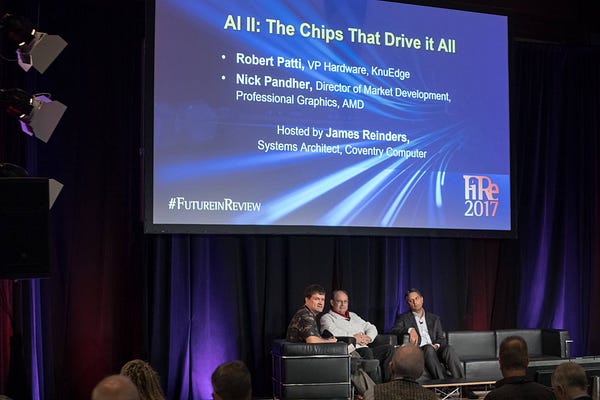FiRe 2017: Cheating on Moore to Get More
By Rainey Cornaby
The third session of the third day of the FiRe conference consisted of a panel of Nick Pandher, Director of Market Development of AMD, and Robert Patti, VP of Hardware at KnuEdge. This session was titled “The Chips That Drive it All,” was moderated by James Reinders, Systems Architect from Coventry Computer, and discussed the present and future of chip design.
Moore’s Law is over, or at a minimum compressed. This is a challenge for chip engineers. Scaling is still being done but more money and resources are being spent per additional transistor. This transition has led to more emphasis placed on chip performance. In part for this reason, the current landscape of chip and architecture design has been referred to as as the Golden Age.
“For a computer architect I don’t think there’s ever been a more exciting time,” said Reinders.
He spoke to his experience working on some of the most significant supercomputers of the past and explained projects today are eons beyond those capabilities.

Patti explained that we are at a fundamental turning point with the compression of Moore’s law. As the rate of increased ability to put transistors onto a chip slows, it creates a more even playing field for new entrants into chip manufacturing. According to Pandher and Patti, it also means new techniques are required to improve computing.
Artificial intelligence (AI) is one method to usher in improvement. Patti explained that instead of using traditional methods to build a new machine and improve based on transistor which attains 5–7% system improvement, more substantial system gains can be achieved through implementation of AI.
“We are planting seeds and these are very primitive, we will get to machine learning squared,” Patti said.
Patti emphasized that right now, platforms are being developed which will move technology to the capability of improving itself. He and Pandher further explained that individuals are taking advantage of hardware in ways not anticipated.
“Looking back, people were taking graphics processor and repurposing that to do compute,” said Patti. “We will see similar repurposing and innovation now.”
The potential of novel packaging, 2.5 and 3 dimensional integration, novel chip materials and photonics in chip and system improvement were also mentioned as ways to cheat Moore’s Law improvements.